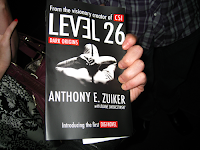 "I used to live in reference libraries," he said, but added that now he prefers staying at home and doing his research online. He said he'd recently asked a reference librarian what she'd been doing with herself lately. She'd said..."editing Wikipedia."
"I used to live in reference libraries," he said, but added that now he prefers staying at home and doing his research online. He said he'd recently asked a reference librarian what she'd been doing with herself lately. She'd said..."editing Wikipedia.". . . said Douglas Coupland in a recent interview he had in Toronto after a reading when he took a potshot at libraries across the world with his apparently innocent quip about the demise of the gates of bricks and books. Much has been said in not only library literature, but in popular writing, too, about the value of public institutions such as libraries. The same goes for academic libraries, where Daniel Greenstein, vice provost for academic planning and programs at the University of California System, told a room full of university librarians that "the university library of the future will be sparsely staffed, highly decentralized, and have a physical plant consisting of little more than special collections and study areas."
It's unnerving to imagine the library of the future as differently as it is from the current day library. But perhaps this is innovation, a reinvention of the model of librarianship as technology transforms society and culture. Librarians need to continually inject fresh ideas to the profession; although, easier said than done with institutional bureaucracies and hierarchies which often overshadow creativity. Decentralization is necessary; and it's about time, too. In my opinion, librarians need to focus on their specialties, and here are some ideas:
1. Research - Librarians need to specialize, and focus on information retrieval. Reference should be conducted by front-line staff; librarians, on the other hand, should do in-depth research which requires more than a duration of a few minutes of a reference transaction. These types of ibrarians should be rebranded as "social science researchers" or "business researchers" to reflect the high quality of work that they do behind the scenes. With the internet and such easy access to information in this connected world, quality reference is the only way to save not only the value, but the public perception of a librarian's work.
2. Collection Management - The literature and lingo says it all: libraries are moving from the physical to the digital. Some public libraries have adapted and increasingly take a proactive bookstore model. Some have even branded this as Library 2.0. But that doesn't seem to be enough. Libraries must start thinking of breaking down a century-old mindset of a Taylor-ist model of operations and to one which requires creativity and economy. Can libraries ever be purely digital online libraries? Can they merge with bookstores? Churches? Malls? Can academic libraries, one of the most traditional institutions of most universities, be ever able to merge with classrooms and student service centres into something extremely unique? We're not talking about learning commons; we're going beyond just the library. To something unthought of yet.
3. Marketing - Fundraising, advertising, communications. Librarians have not been successful yet in the translation of important issues like open access and digitization to a public mass audience. Yet, why is it that corporations like Sony do such a remarkable job at Bravia HDTV and makes masses salivate? Brand management is a niche that libraries must develop even though it's the least of the priorities of librarians. This must change - marketing, social media advertising, event promotions - are the saviours of a languid institution. Libraries are also public spaces; yet, it never attains the same prestige as art galleries or museums. If we expect to survive and achieve relevance, we must adapt.
4. Classifications & Technologies -What is a librarian without knowledge and information management skills? Librarians need to be innovators with not only socia cataloguing, but ultimately the future of the web. Katherine Adams has argued that library and information science and computer science have lots in common in the next version of the web, namely the Semantic Web. These types of librarians, rather than work in inhouse libraries, need to join R&D laboratories, research institutions, and teach in higher education. They need to join the ranks of the intellectual elite.






























